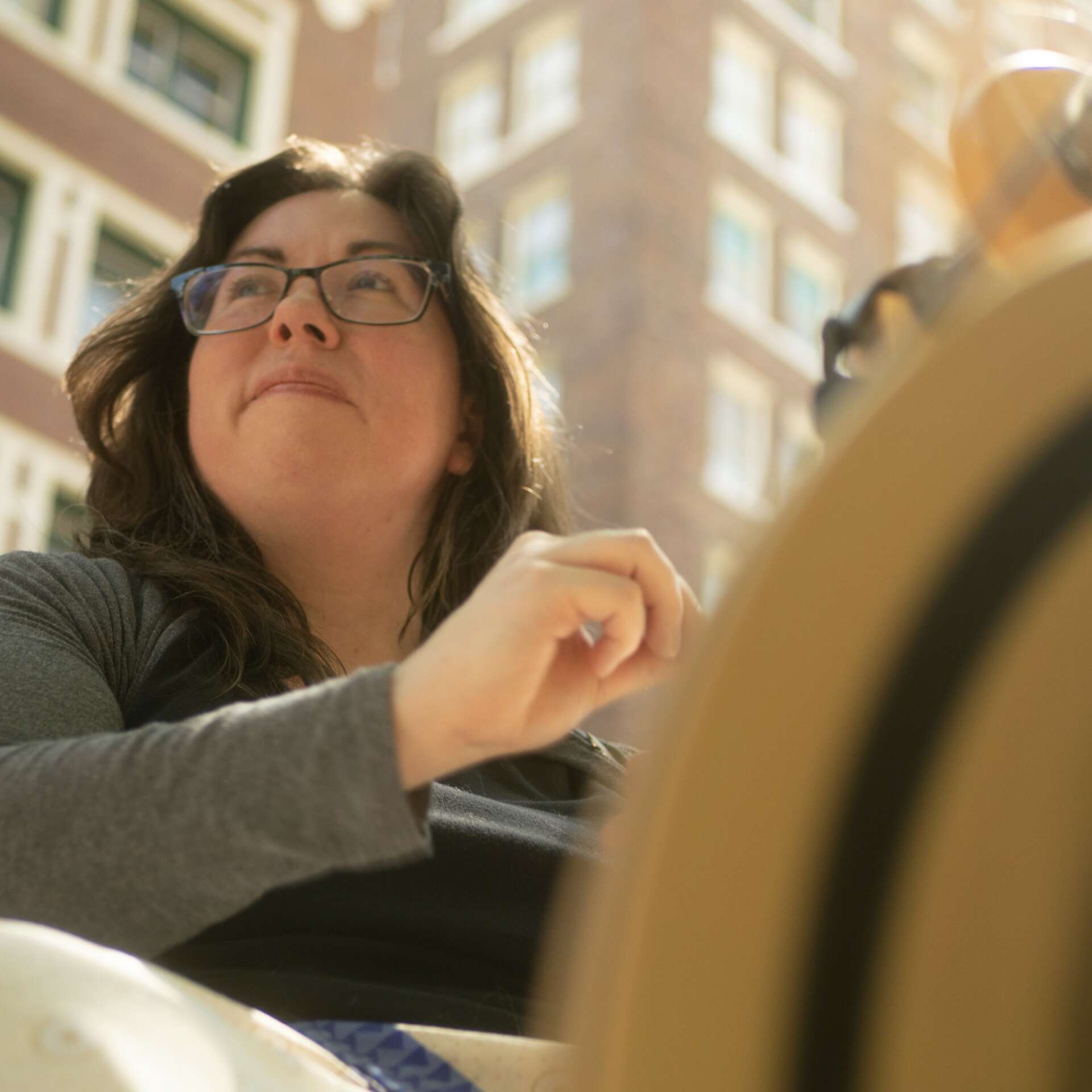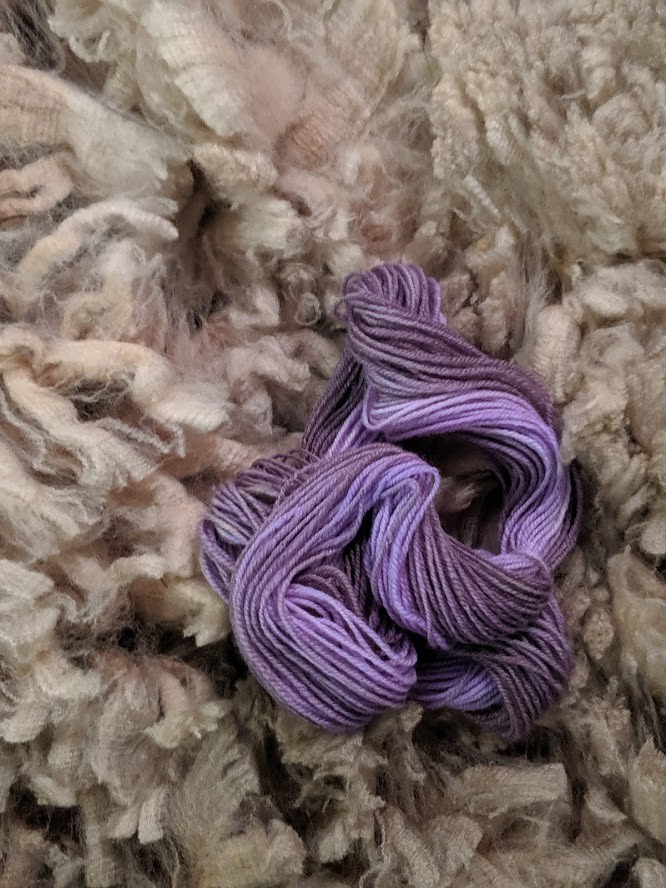We were lucky to catch up with Meagan Condon recently and have shared our conversation below.
Meagan, appreciate you joining us today. Learning the craft is often a unique journey from every creative – we’d love to hear about your journey and if knowing what you know now, you would have done anything differently to speed up the learning process.
How did you learn to do what you do?
I actually MacGyvered my way into making my own yarn. Thanks to my grandmother, I grew up crocheting and doing needlework. We had bags and bags of acrylic yarn always at hand. When I was a teenager, I started to wonder, how did that yarn stay together? What made it… well, yarn. I began twisting and untwisting the cheap, acrylic yarn to try to figure it out. When I had my “aha” moment, I grabbed a candle stub, a coat hanger, and some duct tape. This was before information on spinning was readily available online. Youtube was still several years in the future. I didn’t have the words for what I was doing. I made what I would now call a bottom whorl drop spindle. I didn’t have any wool. But what I did have was a bag of synthetic polyfil, the kind you stuff stuffed animals with. I attached that to my spindle and spun my very first, very scratchy and unpleasant, yarn. Once my curiosity was sated, I set that skill aside until a few years later, when I was in college, when the idea of making my own yarn reemerged and never left again.
Knowing what you know now, what could you have done to speed up your learning process?
The art of handspinning yarn was a widely practiced skill until about the 1930s or 40s, when the advent of commercially viable synthetic textiles really began to take off. As commercial textiles grew, handspinning disappeared from the picture. In the 1970s, there was a resurgence of interest in bringing back these “dying arts” and in the last decade, as information has become easily available online, this interest has grown significantly.
You can’t be curious about something if you don’t know it is an option. Even with the resurgence of interest, handspinning remains a niche art which most crafters don’t think about. Crochet and knitting saturate the fiber arts craft world. Handspinning needs a marketing makeover. We’re already starting to see this happen to a degree with social media driving new interest. But until spinning kits are available at chain craft stores — until it becomes normalized to see someone pull out a spindle on the bus, or while waiting at the DMV — there won’t be an easy entrypoint to this craft.
And that’s what I wish I had had growing up. If I had seen a spindle or spinning wheel in use, I would have arrived at the starting point much sooner, instead of stumbling there through curiousity alone.
What skills are most essential?
The most important skill you need to learn how to spin is patience. I know so many fiber artists are perfectionists or are used to picking up skills quickly. I haven’t met a person whose very first yarn wasn’t lumpy, bumpy, thick and thin. And that’s okay.
My favorite thing to tell students is that frustration is the enemy of learning. If you are frustrated, it has a huge impact on your brain activity, particularly in the frontal and temporal lobes. Guess where problem-solving happens in the brain? If you lose your cool, you don’t form the necessary neural pathways to establish a new skill.
I also tell students to spend no more than 30 minutes each day when they first start spinning. I know how exciting it is to learn a new skill and how you just want to keep doing it. However, from a physical standpoint, your body needs time to build up the hand and arm muscles. And from a psychological standpoint, when you sleep on it, your brain weeds out the less efficient neural pathways, which means that you will be better and faster at a skill the next day if you give yourself time to rest.
What obstacles stood in the way of learning more?
Access to information. See answer to question 2.



Awesome – so before we get into the rest of our questions, can you briefly introduce yourself to our readers.
Meagan Condon is fiber artist with extensive experience. Her areas of focus are microscopy of fiber, breed studies, plant fibers, natural dyes, digital community, and the science behind textiles. She teaches at conferences and retreats across the midwest. You can find her articles in Ply Magazine, Spin-Off Magazine, and Ashford’s The Wheel.
I have worked as a professional fiber artist for over a decade. While it doesn’t have to be an expensive hobby, spinning can certainly grow a hefty price tag once you start investing in speciaty equipment. I learned earily in my career that I wanted all the bells and whistles and that I needed to be able to financially support my craft if I wanted those bells and whistles. I started my business selling custom dyed fiber and hand-carded fiber preparations for other spinners. All of the money I made, I reinvested into equipment and supplies.
Turning my passion into a business allowed me to explore nooks and crannies of the craft that I wouldn’t have otherwise had the financial backing to explore. I was able to grow my knowledge and really figure out what excited me about spinning. I realized that the educational and research pieces are really what was driving my love of fiber arts. I loved learning and I found that I love teaching others. I formed a mission statement around these passion points.
Writing, my other passion which I had gotten my bachelor degree in, writing, slotted in perfectly with the research work I was doing. I began submitting my informational pieces to magazines. Spin-Off picked up my first article on spinning lemongrass in 2018 and a year later, Ply magazine published me in the Bond and Corriedale issue. Since then, I’ve regularly contributed to both magazines as well as some other publications, like Ashford’s The Wheel.
Early on, I experienced some imposter syndrome, but I began to realize that I had invested so much time in learning about fiber arts that I had (accidentally?) become an expert on it. I still sometimes struggle with calling myself an expert. The more you know, the more you realize you don’t know… and you no longer have the assurance of black and white answers. Everything gets so much more complicated. As I’ve begun teaching at some of the largest fiber arts events in the United States and continue to grow my list of publications, I’ve started to own my experience.
As I’ve spent more time writing and teaching, I’ve limited the sales side of my business to materials that support my curriculum. There are other extremely talented fiber artists out there selling amazing indie dyed fibers and handcrafted wooden spindles. Sales support my passion, but they don’t drive my passion.
At this point in my career, I have begun work on a book on plant fibers, which represent a niche within the niche market of spinning. I hope to complete it by mid-2024 You can find my article on blending alpaca and cormo in the Winter 2023 issue of Spin-Off (www.spinoffmagazine.com/). Ply just featured my infographic on micron count and an article on using the different parts of a fleece in the Winter 2022 – Neck and Shoulders issue (www.plymagazine.com). And You can find a piece I did on different plant fibers in the 2022/23 issue of the The Wheel (https://www.ashford.co.nz/ashford-club/the-wheel-magazine).
I’ll be teaching at PlyAway in early 2023 (www.plyaway.com) and am getting classes sorted for two other large conferences in 2023 (I’ll announce these in February).


In your view, what can society to do to best support artists, creatives and a thriving creative ecosystem?
I don’t think it is society that drives support of creative ecosystems. I think creative ecosystems thrive when they invest in themselves. As I answered in an earler question in different words, you can’t know what you don’t know. A society can’t support those crafts which are not already widely known to the society. It is up to the creative communities to market themselves to the wider society in order to obtain support.



Are there any books, videos, essays or other resources that have significantly impacted your management and entrepreneurial thinking and philosophy?
I’m a huge fan of Brene Brown. The Power of Vulnerability and Daring Greatly have both had an enormous impact on how I teach and how I build relationships in the fiber arts world. Leaders Eat Last by Simon Sinek really helped me hone my self-identity as a servant leader. On the fiber arts side, Abby Franquemont’s book Respect the Spindle inspired me to let go of perfectionism.
Contact Info:
- Website: www.luthvarian.com
- Instagram: luthvarian
- Facebook: luthvarian
- Twitter: luthvarian
- Youtube: luthvarian
- Other: I probably should have mentioned this earlier, but I also produce youtube videos as part of my push to educate people on fiberarts.


